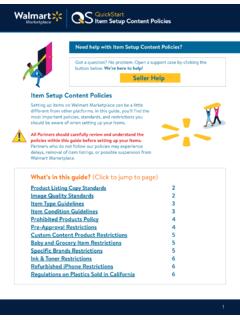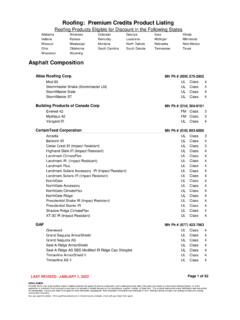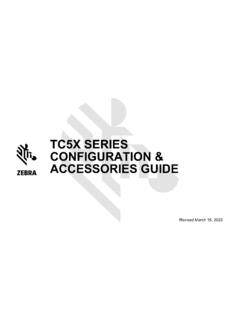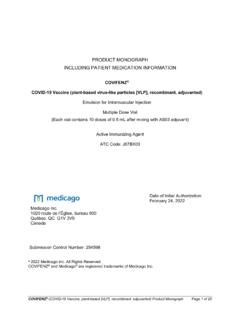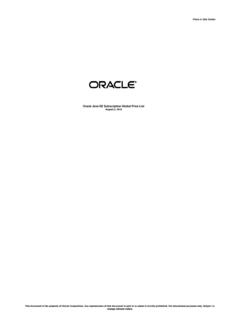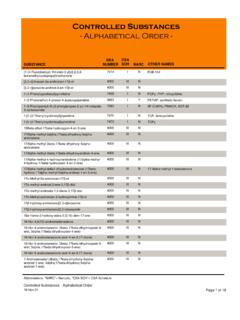Transcription of Twinrix Product Monograph - GSK
1 Product Monograph . Twinrix . Combined hepatitis A (inactivated) and hepatitis B (recombinant) vaccine Suspension for injection Active immunizing agent against infection by hepatitis A and hepatitis B virus ATC Code: J07BC20. GlaxoSmithKline Inc. 7333 Mississauga Road Mississauga, Ontario L5N 6L4. Date of Revision: November 30, 2018. Submission Control No: 2018 GSK group of companies or its licensor. Trademarks are owned by or licensed to the GSK group of companies. Page 1 of 33. Table of Contents PART I: HEALTH PROFESSIONAL INFORMATION ..3. SUMMARY Product INFORMATION ..3. INDICATIONS AND CLINICAL USE ..3. CONTRAINDICATIONS ..4. WARNINGS AND PRECAUTIONS ..4. ADVERSE DRUG INTERACTIONS ..9. DOSAGE AND ADMINISTRATION ..10. OVERDOSAGE ..14. ACTION AND CLINICAL PHARMACOLOGY ..14. STORAGE AND STABILITY ..18. DOSAGE FORMS, COMPOSITION AND PACKAGING.
2 18. PART II: SCIENTIFIC INFORMATION ..20. PHARMACEUTICAL CLINICAL TRIALS ..20. DETAILED PHARMACOLOGY ..21. MICROBIOLOGY ..21. TOXICOLOGY ..22. REFERENCES ..23. PART III: CONSUMER Page 2 of 33. Twinrix . Combined hepatitis A (inactivated) and hepatitis B (recombinant) vaccine PART I: HEALTH PROFESSIONAL INFORMATION. SUMMARY Product INFORMATION. Route of Dosage Form / Nonmedicinal Ingredients Administration Strength Intramuscular Suspension for Aluminium (as aluminium hydroxide and injection injection/ aluminium phosphate), sodium chloride, Twinrix : water for injection. 720 ELISA units Residues*: amino acids for injection, HAV/20 mcg HBV formaldehyde, neomycin sulphate and per 1 mL dose. polysorbate 20. Twinrix Junior: 360 ELISA units HAV/10 mcg HBV. per mL dose. *From the manufacturing process DESCRIPTION. Twinrix [combined hepatitis A (inactivated) and hepatitis B (recombinant) vaccine].
3 Confers immunity against hepatitis A virus (HAV) and hepatitis B virus (HBV) infection by inducing specific anti-HAV and anti-HBs antibodies. INDICATIONS AND CLINICAL USE. Twinrix [combined hepatitis A (inactivated) and hepatitis B (recombinant) vaccine] is indicated for: active immunization against hepatitis A and hepatitis B virus infection in adults, adolescents, children and infants. Page 3 of 33. The vaccine will not protect against infection caused by other agents such as hepatitis C, hepatitis E and other pathogens known to infect the liver. It can be expected that hepatitis D will also be prevented by immunization with Twinrix as hepatitis D. (caused by the delta agent) does not occur in the absence of hepatitis B infection. CONTRAINDICATIONS. Twinrix [combined hepatitis A (inactivated) and hepatitis B (recombinant) vaccine].
4 Should not be administered: to subjects with known hypersensitivity to any constituent of the vaccine, or to subjects having shown signs of hypersensitivity after previous administration of Twinrix or monovalent hepatitis A or hepatitis B vaccines. Twinrix contains traces of neomycin. The vaccine should not be used in subjects with known hypersensitivity to neomycin. For a complete listing , see the DOSAGE FORMS, COMPOSITION AND. PACKAGING section of the Product Monograph . As with other vaccines, the administration of Twinrix should be postponed in subjects suffering from acute severe febrile illness. The presence of a minor infection, however, is not a contraindication for vaccination. WARNINGS AND PRECAUTIONS. General As with all injectable vaccines, appropriate medication ( adrenaline) should always be readily available in case of anaphylaxis or anaphylactoid reactions following administration of the vaccine.
5 For this reason, the vaccinee should remain under medical supervision for 30 minutes after immunization. Since there is a possibility that the vaccine may contain trace amounts of neomycin, the possibility of an allergic reaction in individuals sensitive to this substance should be kept in mind when considering the use of this vaccine (see DOSAGE FORMS, COMPOSITION AND PACKAGING). It is possible that subjects may be in the incubation period of a hepatitis A or hepatitis B. infection at the time of vaccination. It is not known whether Twinrix [combined hepatitis A (inactivated) and hepatitis B (recombinant) vaccine] will prevent hepatitis A. and hepatitis B in such cases. Syncope (fainting) can occur following, or even before, any vaccination as a psychogenic response to the needle injection. It is important that procedures are in place to avoid injury from faints.
6 Twinrix should under no circumstances be administered intravascularly. Page 4 of 33. Hematologic Twinrix can be administered subcutaneously to subjects with thrombocytopenia or bleeding disorders since bleeding may occur following an intramuscular administration to these subjects. Subcutaneous injection may result in a less than optimal antibody response. Immune As with other vaccines, in persons with an impaired immune system, adequate anti-HAV. and anti-HBs antibody titres may not be obtained after the primary immunization course, and such patients may therefore require administration of additional doses of vaccine. However, no specific dosing recommendations can be made at this time. Renal As with other vaccines, hemodialysis patients may not obtain adequate anti-HAV and anti-HBs antibody titres after the primary immunization course and such patients may therefore require administration of additional doses of vaccine.
7 However, no specific dosing recommendations can be made at this time. Special Populations Pregnant Women: Twinrix should be used during pregnancy only when clearly needed, and when the possible advantages outweigh the possible risks for the fetus. The effect of Twinrix on embryo-fetal, peri-natal and post-natal survival and development has not been prospectively evaluated in clinical trials. The effect of Twinrix on embryo-fetal, peri-natal and post-natal survival and development has been assessed in rats. Such animal studies do not indicate direct or indirect harmful effects with respect to fertility, pregnancy, embryonal/fetal development, parturition or post-natal development. Nursing Women: Adequate human data on use during lactation and adequate animal reproduction studies are not available. Twinrix should therefore be used with caution in breastfeeding mothers.
8 ADVERSE REACTIONS. Clinical Trial Adverse Drug Reactions Because clinical trials are conducted under very specific conditions the adverse reaction rates observed in the clinical trials may not reflect the rates observed in practice and should not be compared to the rates in the clinical trials of another drug. Adverse drug reaction information from clinical trials is useful for identifying drug-related adverse events and for approximating rates. Page 5 of 33. Adults The safety profile presented below is based on data from more than 6,000 subjects who received Twinrix at either the standard 3-dose 0, 1, 6 month schedule or the rapid 4- dose 0, 7, 21 days primary schedule. In a clinical trial where Twinrix was administered at 0, 7, 21 days, solicited general symptoms were reported with the same categories of frequency as defined below.
9 After a fourth dose (booster) given at month 12, the incidence of systemic adverse reactions was comparable to that seen after vaccination at 0, 7, 21 days. Adverse reactions considered by the investigator as being at least possibly related to Twinrix vaccination in adults Frequency Adverse Event System/Organ Class Very Common: Headache Nervous system disorders 10% pain and redness at the injection site, General disorders and fatigue administration site conditions Common: gastrointestinal symptoms (such as Gastrointestinal disorders 1% and < 10% diarrhea, nausea, vomiting). swelling at the injection site, injection General disorders and site reaction, malaise administration site conditions Uncommon: upper respiratory tract infection Infection and infestations and < 1% Dizziness Nervous system disorders Myalgia Musculoskeletal and connective tissue disorders fever ( C) General disorders and administration site conditions Rare: Lymphadenopathy Blood and lymphatic system and < disorders decreased appetite Metabolism and nutrition disorders hypoaesthesia, paraesthesia Nervous system disorders Hypotension Vascular disorders rash, pruritus Skin and subcutaneous tissue disorders Arthralgia Musculoskeletal and connective tissue disorders influenza like illness, chills General disorders and administration site conditions Very Rare.
10 Urticaria Skin and subcutaneous tissue < disorders In a comparative study it was noted that the frequency of the solicited adverse events following the administration of Twinrix is not different from the frequency of the solicited adverse events following the administration of the monovalent vaccines. Page 6 of 33. Pediatric The safety profile presented below is based on data from approximately 800 subjects who received Twinrix Junior at the standard 3-dose 0, 1, 6 month schedule. Adverse reactions considered by the investigator as being at least possibly related to Twinrix Junior vaccination in children Frequency Adverse Event System/Organ Class Very Common: pain and redness at the injection site General disorders and 10% administration site conditions Common: appetite lost Metabolism and nutrition disorders 1% and < 10% Irritability Psychiatric disorders drowsiness, headache Nervous system disorders gastrointestinal symptoms (such as Gastrointestinal disorders nausea, diarrhea*, vomiting).
